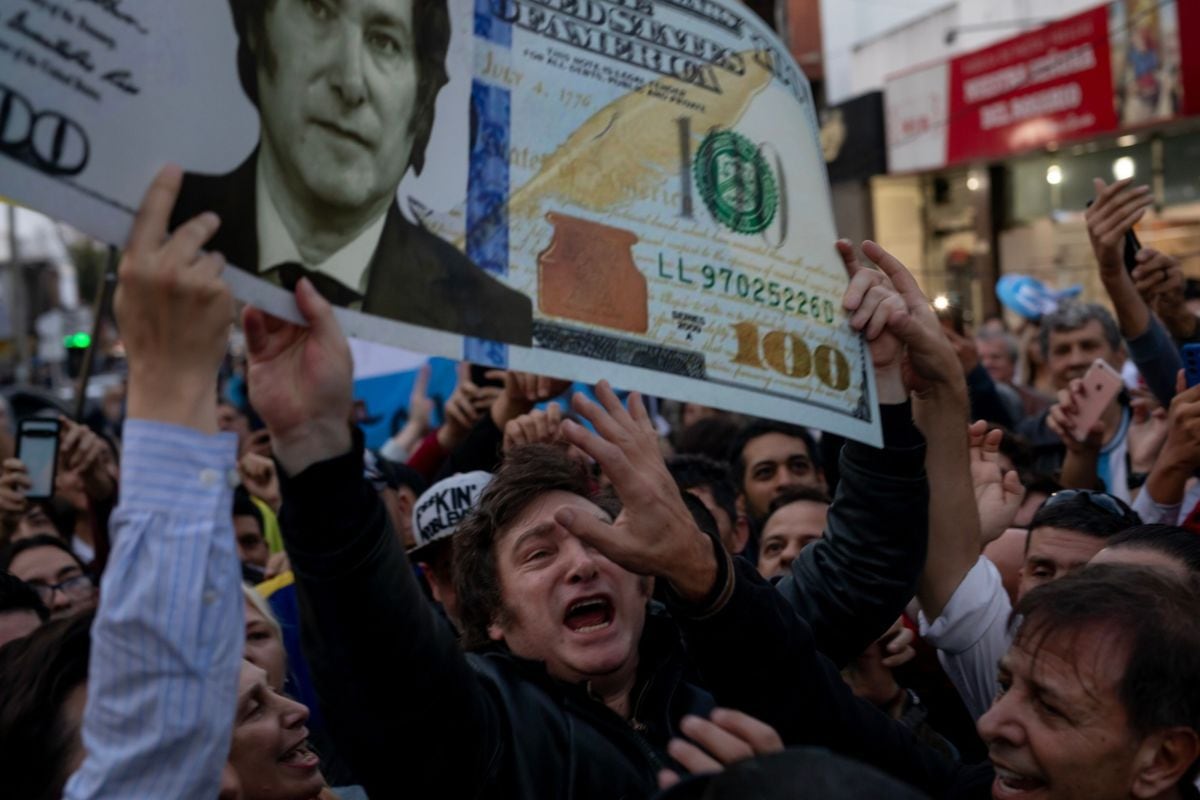
Argentina debate the dollarization of its economy after decades of failure to tame the inflationabove three digits in 2023, given the proposal of the far-right candidate Javier Mileiwell placed to achieve the Presidency, which permeates a society tired of the loss of its purchasing power.
For experts it is a waste of time. “It is not a good idea and the dollars are not there”, “with which, the entire debate becomes abstract” and “That’s why we’re wasting our time.”says Federico Poli, director of the consultancy Sistemica and one of the almost 200 economists who recently signed a public warning about the danger of the measure.
With the flag of dollarization, eliminate the Central Bank and apply ‘chainsaw’ to public spending, the La Libertad Avanza candidate obtained first place (29.86%) in the August 13 primaries.
Milei says he has five projects to dollarize, although at the same time he rules out implementing it in the short term and talks about “coin competition”.
His advisors relativized the possibility of dollarizing due to the lack of foreign currency and political support, modified the proposal to eliminate the Central Bank to regulate it and admitted the difficulty of removing exchange restrictions due to the debt issued by the monetary entity.
In a society that distrusts the peso and uses the dollar as a savings currency and for transactions such as the purchase of property, dollarization dominates public discussion ahead of the October 22 elections.
However, the main candidates reject adopting the dollar as legal tender.
Bimonetarism (peso-dollar coexistence) is what Patricia Bullrich, former Minister of Security with Mauricio Macri (2015-2019) and candidate for Together for Change (center-right), proposes.
Sergio Massa, current Minister of Economy and official candidate (Unión por la Patria, Peronism), has not proposed a change.
Mirage
The threat of dollarization is such that more than 170 economists from various schools of thought warned that dollarization “It’s a mirage.”
Macroeconomists talk about “insurmountable obstacles”since Argentina lacks the dollars necessary to rescue the monetary base and support bank deposits and, to obtain them, the proposals suppose “absurd increases” of public debt, for a country whose securities are quoted at 30% of their parity.
These economists understand that the “only alternative” is to dollarize at such a high exchange rate that it would cause “a (hyper)inflationary outbreak”, on a society that is already 40% poor, and a violation of property rights.
If adopted, it will be “serious”, Poli points out, because Argentina would be “without such a basic instrument of economic policy as monetary and exchange rate policy” and would suffer what it already experienced at the end of convertibility.
Record
Argentina adopted the convertibility of one peso for one dollar in 1991, which stabilized prices by preventing the Central Bank from issuing currency without foreign currency support, but it collapsed in 2002, with a huge socioeconomic crisis.
The ‘1 to 1’ was welcomed after Argentina suffered two hyperinflations, at the end of the presidency of Raúl Alfonsín (1983-1989) and at the beginning of that of Carlos Menem (1989-1999), and before that by ‘Rodrigazo’, a 100% exchange rate jump and a triple-digit inflationary burst in 1975, which followed years of inflation since the 1950s.
Argentina, according to experts, has inflation due to the constant imbalance of fiscal accounts, which when it cannot finance them with taxes or public debt it does so with monetary issue, which raises the amount of money above people’s demand, increasing the prices.
The Central Bank has consequently been overwhelmed to prevent its autonomy and comply with the monetary financing required by the Treasury.
“What Argentina has to do is not take shortcuts” and “put public accounts in order”says Poli, because ““We are discussing this nonsense (nonsense)”, “instead of looking at how to reduce public spending in the least painful way.”
Inflation accelerated again in 2005 and the Government of Néstor Kirchner (2003-2007) responded by intervening since 2007 by the National Institute of Statistics and Censuses (Indec) to underestimate the CPI, but it continued to accelerate to 26.9% annually at the end of the management of Cristina Fernández (2007-2015).
The Indec was normalized in the Macri Government, but his management ended with 53.8% annually due to applying a gradualist policy to reduce the fiscal deficit and despite resorting to a program with the IMF at the end of the mandate.
The fall in purchasing power led society to elect the Peronist Alberto Fernández (2019-2023), who has brought inflation to 124.4% year-on-year.
Hence the idea of earning in dollars that Milei inspires attracts so many followers, while he calls “failed” and “accomplices in the politicians’ scam” those who think against him.
Its prohibition in the Constitution, as cited by the president of the Supreme Court, Horacio Rosatti; The uncertainty about the composition of the Congress that will emerge in October and the threat of a binding popular consultation are other elements to conclude that the debate on dollarization is a waste of time for current Argentina.
Source: EFE
Source: Gestion
Ricardo is a renowned author and journalist, known for his exceptional writing on top-news stories. He currently works as a writer at the 247 News Agency, where he is known for his ability to deliver breaking news and insightful analysis on the most pressing issues of the day.












